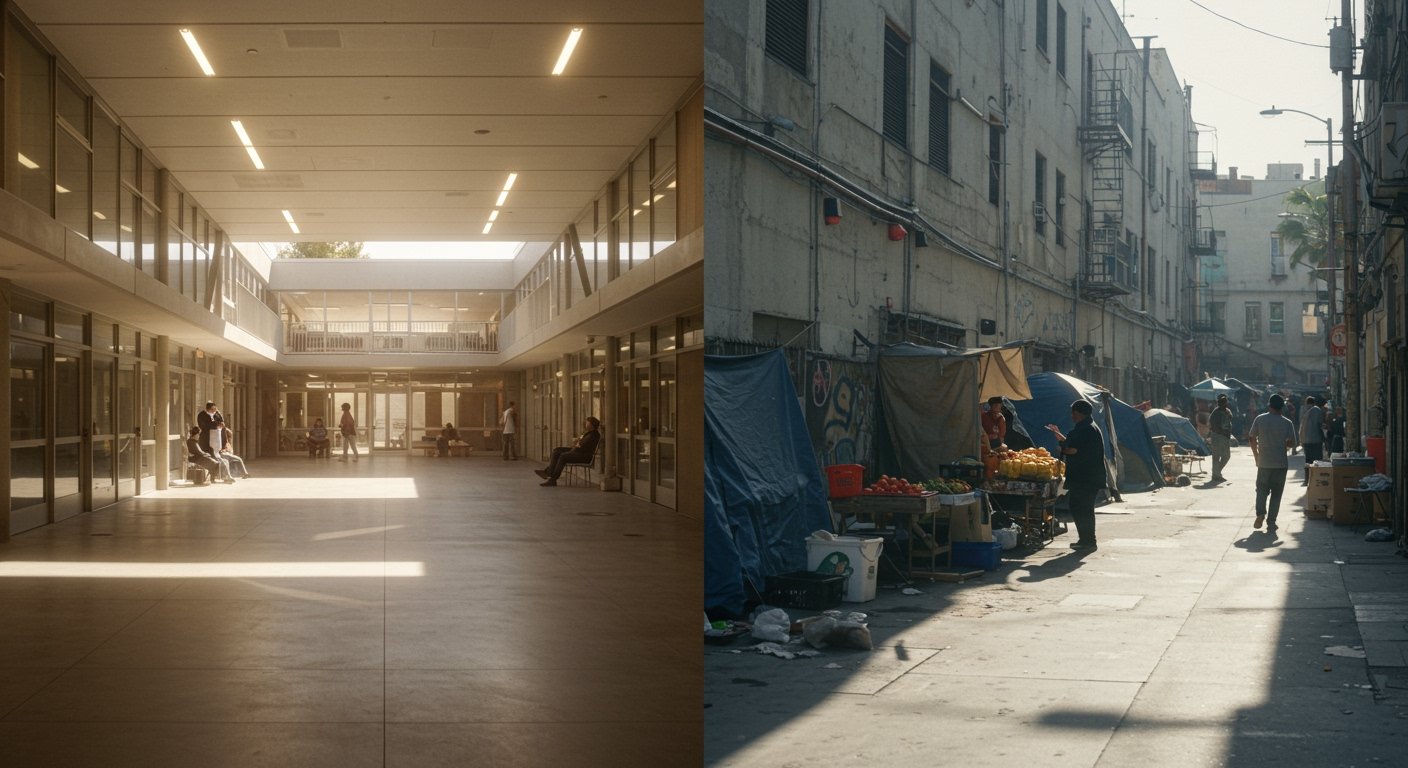Los Angeles, CA – In a stark divergence from a national climate increasingly characterized by hostility toward illicit drug use and the visible manifestation of homelessness, the city of Los Angeles is actively pursuing an alternative strategy. At the epicenter of its persistent homelessness crisis, within the densely populated Skid Row area, a new facility has opened its doors, embodying an approach centered on comprehensive care and relative leniency.
This initiative is encapsulated by the Skid Row Care Campus, a purpose-built structure situated in the heart of Skid Row. Officially inaugurated this spring, the campus represents a tangible investment in addressing the complex needs of individuals experiencing homelessness in one of the city’s most challenged neighborhoods.
A Haven in Contrast
The Skid Row Care Campus was conceived as more than just a shelter; it aims to provide a range of essential services designed to offer stability and support. Among the key provisions available to homeless individuals are access to showers and laundry facilities, addressing fundamental hygiene needs often unmet on the streets. Crucially, the campus also offers medication for addiction treatment (MAT), a critical component in addressing substance use disorders prevalent within the homeless population.
Beyond these vital services, the campus provides a degree of respite and a sense of security. It features a covered courtyard, offering a sheltered space where people can congregate, relax, and escape the immediate pressures of street life. The availability of power outlets allows individuals to charge essential personal devices, such as phones, fostering connection and access to information. These offerings collectively aim to create an environment of support and dignity. [17]
The Harsh Reality Outside
The environment immediately surrounding the Skid Row Care Campus underscores the profound challenges the facility seeks to mitigate. The adjacent sidewalks present a stark contrast to the relative calm within the campus walls. This area is characterized by the dynamic and often precarious conditions of street life in Skid Row. Pop-up fruit stands operate alongside sprawling tent encampments, illustrating the informal economy and housing crisis converging in the district.
More troublingly, the area is known for open-air drug markets, where highly potent and dangerous substances like methamphetamine and fentanyl are openly sold. The devastating impact of this illicit activity is visible; individuals can frequently be observed passed out on the sidewalks, victims of overdose or severe intoxication. [17]
The Policy Divergence
The juxtaposition of the supportive environment within the Skid Row Care Campus against the chaotic and perilous reality of the surrounding streets highlights a deliberate policy choice by Los Angeles. This approach, focusing on providing services and creating safe spaces, is explicitly presented as the city attempting a path of leniency. This contrasts sharply with a broader national trend that has seen increasing calls for stricter enforcement, punitive measures, and less tolerance for drug use and homelessness in public spaces. [17]
The national discourse in many areas has shifted towards prioritizing public order and often criminalizing aspects of homelessness and addiction. This includes debates around clearing encampments more aggressively and imposing harsher penalties for drug offenses. Against this backdrop, Los Angeles’ investment in a comprehensive care campus, emphasizing treatment and supportive services, represents a significant philosophical and practical divergence.
Weighing the Approach
The decision by Los Angeles to pursue this course of action reflects a recognition of the complex, intertwined issues of addiction, mental health, and poverty that contribute to homelessness. Proponents of the Skid Row Care Campus model argue that simply displacing individuals or enacting stricter laws without providing viable alternatives and treatment pathways is ineffective and inhumane. They contend that offering services like addiction treatment medication, showers, and a safe place to rest is a necessary first step in helping individuals stabilize their lives and potentially move towards permanent housing and recovery.
However, this approach is not without its challenges and critics. The continued presence of open-air drug markets and visible struggles with addiction immediately outside the campus gates underscore the immense scale of the problem and the limitations of a single facility. Skeptics may question whether providing services within a known drug hotspot inadvertently normalizes or fails to adequately address the illicit activity. The long-term effectiveness of this leniency-based strategy in significantly reducing homelessness and drug use across Skid Row and the wider city remains a subject of ongoing evaluation and debate.
The Skid Row Care Campus, operational since spring, stands as a prominent example of Los Angeles’ commitment to a specific, care-oriented strategy in the face of a national mood that often favors more punitive responses. Its success, or lack thereof, will likely inform future approaches in Los Angeles and may serve as a case study for other municipalities grappling with similar challenges while navigating differing political and social currents.
Looking Ahead
As the Skid Row Care Campus continues its operations, stakeholders will closely monitor its impact on the lives of those it serves and on the broader conditions in the surrounding area. The contrast between the services offered inside and the harsh realities outside will continue to be a focal point, illustrating the profound complexities inherent in addressing homelessness and addiction in a major urban center like Los Angeles, particularly within a national context that is still grappling with finding effective and compassionate solutions.





